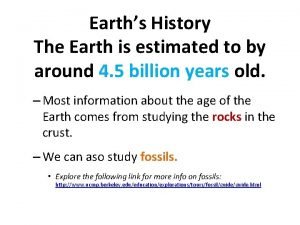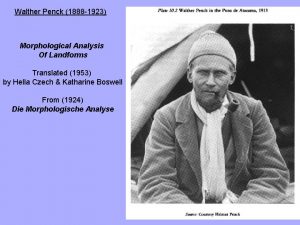SEDIMENT DISPERSAL IN TRIASSIC FLUVIAL SYSTEMS OF SOUTHWEST

- Slides: 1

SEDIMENT DISPERSAL IN TRIASSIC FLUVIAL SYSTEMS OF SOUTHWEST LAURENTIA: INSIGHTS FROM U-PB AGES OF DETRITAL ZIRCON GRAINS William R. Dickinson, George E. Gehrels, Jennifer D. Fox, Kelley N. Stair, Carl E. Anderson, Jaika Ojha, Richard A. Brown, Michael B. Norton (University of Arizona) Nancy R. Riggs (Northern Arizona University) and Thomas M. Lehman (Texas Tech University) U-Pb ages of detrital zircons (DZ) in 20 samples of Triassic fluvial sandstone (Moenkopi, Chinle, Dockum) on the Colorado Plateau and NM-TX High Plains provide insight into Triassic sediment dispersal in southwest Laurentia (~100 individual grain ages per sample from LA-ICP-MS with a beam diameter of 35 microns; average of 92 reliable grain ages per sample after rejection of ages with >20% discordance or >10% uncertainty; total of 1846 individual DZ zircon ages). U-Pb age populations fall into four groups: (1) Lowermost Chinle-Dockum (n=3) from the NE fringe of exposures (TX Santa Rosa, NM Tecolotito, UT Gartra): 35%-70% Cambrian grains (540 -500 Ma; peaks 525 -515 Ma) derived from the Amarillo-Wichita uplift or its Paleozoic cover, but no <300 Ma grains, with Gartra of NE UT evidence for Late Triassic sediment transport across eroded roots of Paleozoic Ancestral Rocky Mountains uplifts. (2) Lower to Middle Triassic Moenkopi (n=2), derived from the SE, and lower Chinle (Carnian) Shinarump (n=3) from paleovalleys trending SSE to NNW (AZ-UT): dominated by Proterozoic grains (30%-60%; 1785 -1400 Ma) derived from Yavapai-Mazatzal basement (intruded by anorogenic plutons) and Permian-Triassic grains (20%-40%) derived from both Cordilleran (250 -220 Ma) and East Mexico (295 -260 Ma) magmatic arcs; similar DZ in upper Chinle (Norian) Sonsela also derived from the south. (3) Lower Chinle (Carnian) Shinarump (n=3) and correlative Santa Rosa (NM; n=1) along the Chinle. Dockum trunk paleoriver (course ESE to WNW across Colorado Plateau): heterogeneous DZ including Grenville (40%-50%; 1290 -1000 Ma) and Neoproterozoic-Paleozoic (15%-20%; 640320 Ma) grains recycled from the Ouachita orogen, with arc-derived grains sparse (<10%); closely matching DZ downstream in a Chinle outlier at Currie NV within the Great Basin. (4) Upper Chinle (Norian) of the Cottonwood paleovalley (n=4), subparallel to the lower Chinle paleoriver but farther northeast: also heterogeneous DZ with even more Neoproterozic-Paleozoic grains (30%-40%; 690 -310 Ma) but Grenville (20%-30%) still dominant over Yavapai-Mazatzal (10%-15%); broadly similar DZ in correlative upper Chinle-Dockum upstream on the High Plains (n=3), though with more arc-derived grains (275 -210 Ma; 15%-25%). Our study shows the utility of detrital zircon ages for helping to delineate paleodrainage patterns in ancient fluvial systems. Methodology SAMPLE COLLECTION AND PREPARATION -About thirty pounds of clean/fresh rock was collected from outcrop -Sample was crushed and pulverized using a jaw crusher and roller mill -Pulverized sample placed on Wilfley table to separate grains by density and sieved to collect zircons of <350 microns -Grains further separated by density using heavy liquids (Methylene Iodide) -Final grain separation using a Frantz magnetic separator -Sample with >90% purity of zircon grains was mounted in epoxy within 1” diameter rings and sanded down ~40 microns depth to expose zircon interiors DATA COLLECTION AND REDUCTION -U-Pb ages were obtained using a Laser-Ablation Multicollector ICP Mass Spectrometer -1000 zircon grains (100 per sample) were individually ablated (laser diameter = 35 -50 microns) with standard zircon grains (age = 564 Ma) being ablated between every five (5) unknowns grains -Data was corrected for U/Pb and Pb/Pb fractionation and for common lead (using measured 204 Pb) -Ages were calculated from the isotope ratios of 206 Pb/238 U and 206 Pb/207 Pb -Data accuracy and precision was evaluated using a Pb/U Concordia diagram. Data with >20% discordance or >10% uncertainty were removed (see Concordia plot) -206 Pb/238 U ages (for <1. 0 Ga grains) and 206 Pb/207 Pb ages (for >1. 0 Ga grains) were plotted on an age probability plot (see age probability plots) CP 42: Shinarump (lower Chinle) in Wolverine Canyon of Circle Cliffs UT Confreres for Collecting Ronald C. Blake Spencer G. Lucas John H. Stewart Key Conclusions • The Moenkopi deposystem occupied the distal cratonward flank of the Sonoma proforeland basin, and the Chinle-Dockum deposystem occupied an elongate backarc basin formed by dynamic subsidence behind the Cordilleran arc in response to subduction of a mantle slab beneath the retroarc foreland. • On the northeast, basal Chinle-Dockum strata contain abundant Cambrian detrital zircons derived from granite forming part of the deformed aulacogen floor of the Amarillo-Wichita uplift, and grains from the same source dominate the Gartra DZ population of the Eagle paleoriver which flowed across or through eroded Pennsylvanian uplifts of the Ancestral Rocky Mountains Province in Colorado. • The principal lower Chinle-Dockum paleodrainage (Carnian) was a trunk paleoriver flowing from the Ouachita foreland of the High Plains through the site of the San Juan basin and across the Colorado Plateau toward the Chinle outlier at Currie NV, and carried large DZ fractions of Grenville and Neoproterozoic-Paleozoic grains recycled from the Ouachita orogen. • Multiple southern tributaries entering the trunk paleoriver from the south contributed DZ populations similar to those in older Moenkopi sands derived in large part from Yavapai-Mazatzal basement and the Permian-Triassic East Mexico arc of southwest Laurentia lying southeast (uppaleocurrent) from the Colorado Plateau. • The upper Chinle-Dockum Cottonwood paleovalley (Norian) lay geographically between the two older (Carnian) paleorivers, with its headwater reaches in the Ouachita foreland, and also carried a high proportion of Neoproterozoic-Paleozoic-Grenville DZ recycled from the Ouachita orogen. Chronostratigraphy of Colorado Plateau–High Plains Triassic (showing Moenkopi samples) Church Rock/Rock Point interval treated here as basal Glen Canyon Group Timescale: pre-220 Ma after Brack et al. (2005); post-220 Ma after Gradsteinh et al. (2004) Schematic transects of sampled Upper Triassic Chinle–Dockum sandstone lithosomes (variably formations or members of group or formation) on Colorado Plateau (1 -4) and High Plains (5 -6) [note multiple paleovalley fills] Triassic outcrop-subcrop on Colorado Plateau and High Plains Preserved extent of lower Chinle-Dockum (Carnian) deposystem on Colorado Plateau and High Plains (crosses denote sample localities except asterisk for Currie inlier of Great Basin (NV) Preserved extent of upper Chinle-Dockum (Norian) deposystem on Colorado Plateau and High Plains (crosses denote sample localities and course of Cottonwood paleovalley shown) Preserved extent of Lower to Middle Triassic Moenkopi deposystem of Colorado Plateau and High Plains (crosses denote sample localities) Age-distribution curves of samples with dominant/prominent peaks for Cambrian grains derived from the Amarillo-Wichita uplift (Gartra also includes subordinate Proterozoic grains contributed in transit across basement of the Ancestral Rocky Mountains Province in Colorado) Chinle-Dockum paleorivers (trends subparallel to tectonic axis of dynamic backarc basin) sandstone detrital modes Age-bin histograms (blue) and age-distribution curves (red) for lower Chinle-Dockum (Carnian) samples collected along course of trunk paleoriver (note the relative abundance of recycled Paleozoic-Neoproterozoic-Grenville grains from Ouachita orogen) Age-bin histograms (blue) and age-distribution curves (red) for upper Chinle-Dockum (Norian) samples collected along course of Cottonwood paleovalley and its headwaters (note relative abundance of recycled Paleozoic-Neoproterozoic-Grenville detritus from Ouachita orogen) CP 26: Poleo (upper Chinle) in roadcut on US 84 near Abiquiu Reservoir NM Research Support NSF Grant EAR-0341987 Arizona Laser. Chron Center Permits for Collecting Navajo Nation and Hopi Tribe Grand Staircase-Escalante NM Anton Chico Land Grant Composite DZ populations in Moenkopi and southern Chinle (N=samples; n=grain ages) Age-bin histograms (blue) and age-distribution curves (red) for Moenkopi and southern Chinle samples (note abundance of 1400 -1900 Ma Yavapai-Mazatzal and anorogenic granite detritus from south of the Colorado Plateau, as well as spikes of arc-derived grains from the southeast) Composite age-distribution curves for Carnian Lower Chinle. Dockum (trunk paleoriver and terminus) and Norian Upper Chinle -Dockum (Cottonwood paleovalley and headwaters) (N = samples; n = grain ages) CP 42: Shinarump (lower Chinle) quartzose sandstone Wolverine Canyon of Circle Cliffs UT CP 5: Trujillo (upper Chinle) sublitharenite, roadcut on NM 104 near Conchas Reservoir NM

